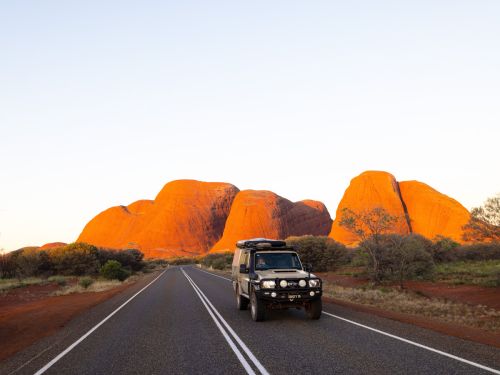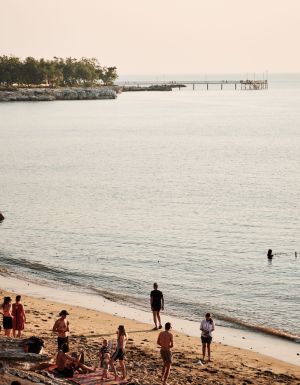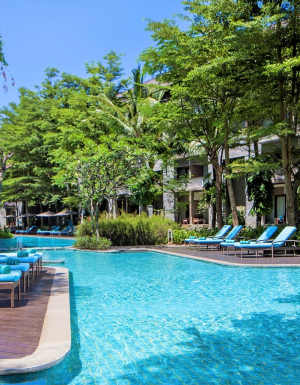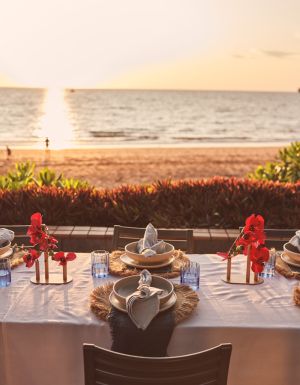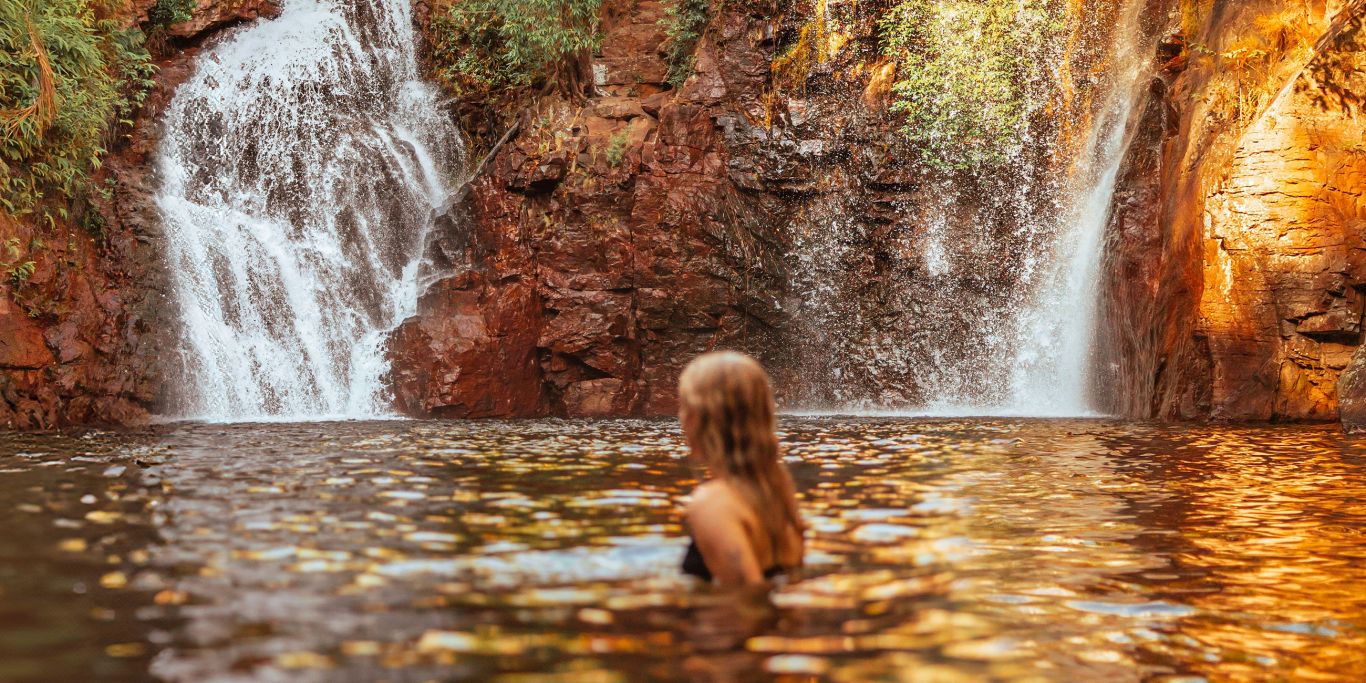The drive from Darwin to Uluṟu is no ordinary road trip – it’s a bucket list journey through some of Australia’s most unforgettable landscapes. Wind your way past towering termite mounds, lush tropical bush, and that deep red earth the Northern Territory is famous for, with roadhouses, hot springs, art centres and shady plunge pools breaking up the kilometres.
This guide covers the best stops, driving distances, road conditions, accommodation options, and insider tips to help you plan the perfect trip.
Best time to take a Darwin to Uluṟu road trip

The dry season (May to September) is the best time for a Darwin to Uluṟu road trip, offering clear skies, cooler temperatures and fewer road closures. The wet season (November to April) can bring flooding, intense heat and unpredictable road conditions, making travel more challenging.
Darwin to Uluṟu distance and drive time
Total distance: 1,950 km
Recommended duration: 7 to 14 days
Road conditions: Fully sealed highways, with some unsealed detours if you venture off the Stuart Highway
Darwin to Katherine (320 km, about 3.5 hours)

Wave goodbye to Darwin’s sea breeze and head south – first stop, Litchfield National Park, home to croc-free swimming spots like Wangi Falls and Buley Rockhole, where cool cascades and shady pools deliver instant relief from the heat. Further down the track, the Adelaide River region offers two contrasting pit stops: get your heart racing on a Jumping Croc Cruise, where salties launch from the water just metres from the boat, or slow things down at the beautifully kept Adelaide River War Cemetery, a moving tribute to those who served in WWII.

Just before Katherine, take a detour left to Edith Falls (Leliyn) boasting gorgeous swimming holes framed by red cliffs, grassy banks and a series of waterfalls. Once in Katherine, drift through the warm, glassy hot springs, where little turtles paddle alongside and kids launch into the main pool with cannonball flair. Then it’s on to Nitmiluk (Katherine) Gorge, where towering cliffs and a winding river set the scene for boat cruises, overnight kayaking trips or scenic hikes with views that are well worth the effort.
Where to stay

For a luxe stay right in the heart of nature, Cicada Lodge delivers – think elegant rooms, stunning views, and a close connection to the surrounding landscape of Nitmiluk National Park. If you’re after something mid-range, Knotts Crossing Resort is a solid pick – comfortable, close to town, and with a pool that’s a lifesaver in the heat. Travelling on a budget or keen to camp? Discovery Parks – Katherine has you covered with shady sites, a relaxed vibe and fresh, well-equipped two-bedroom cabins if you’re after a bit more comfort.
Katherine to Tennant Creek (675 km, about 7 hours)

The drive south leads to Mataranka, home to the stunning thermal pools surrounded by lush palms, where you can float in warm, crystal-clear water before heading to the famous Daly Waters Pub . This legendary outback watering hole is adorned with bras, banknotes, and road trip memorabilia, making it an essential stop for a burger and a cold drink in true Territory style. Further down the highway, Karlu Karlu (Devil’s Marbles) appears as giant, rounded boulders seemingly stacked by nature itself.
Where to stay

Accommodation is sparse between Katherine and Tennant Creek, but Daly Waters Pub offers a lively overnight stop with quirky rooms and a classic roadhouse atmosphere. In Tennant Creek, Bluestone Motor Inn is a reliable mid-range option, providing comfortable rooms and a pool. For a more rugged experience, Banka Banka Station offers budget-friendly camping and cabins on a working cattle station.
Tennant Creek to Alice Springs (510 km, about 5 hours)

The vast outback stretches ahead, with Barrow Creek Telegraph Station offering a glimpse into Australia’s early communication history, complete with eerie remnants of the past. Further south, the Tropic of Capricorn Marker signals the transition into the arid heart of the country, where the landscape becomes more dramatic and the horizon stretches endlessly. Closer to Alice Springs, Simpsons Gap in the West MacDonnell Ranges is a must-visit, with towering cliffs framing a peaceful waterhole that often attracts black-footed rock wallabies.
Where to Stay

For a dose of top-end comfort, Crowne Plaza Alice Springs Lasseters delivers with 205 roomy stays, multiple dining spots, a superb pool and a fitness centre that’s basically a gym lover’s dream. Nearby, DoubleTree by Hilton offers 228 sleek rooms and those signature warm cookies on check-in – plus prime access to the casino and convention centre. Travelling light on the wallet? Discovery Parks – Alice Springs has you covered, with a well-equipped, family-friendly caravan park that doesn’t skimp on amenities.
Alice Springs to Kings Canyon (330 km, about 3.5 hours)

The road west leads into the breathtaking West MacDonnell Ranges, home to the formidable 223-kilometre Larapinta Trail – a demanding, multi-day trek that ranks among Australia’s toughest.
Along the way, you’ll stumble upon some unmissable spots: Simpsons Gap, where sheer red cliffs loom overhead and black-footed rock wallabies dart between shadows; Ellery Creek Big Hole, offering a bracing (read: freezing) dip in its serene waterhole; and Standley Chasm, which blazes fiery red when the midday sun hits just right.

The historic Ochre Pits deserve a detour for their vivid earth pigments, while Ormiston Gorge and Glen Helen provide a double hit of dramatic cliffs and cool, swimmable waters. Don’t miss the four-hour Kings Canyon Rim Walk, a challenging yet unforgettable hike offering panoramic views over the canyon’s rugged landscape.
Where to stay

If you’re after a resort-style escape, Discovery Resorts – Kings Canyon serves up hotel rooms and glamping tents with outback views that do all the talking. For something more rugged, Kings Creek Station – a working cattle station 36km from Kings Canyon – offers safari tents, cabins and classic camping under the stars, along with buggy tours that kick up some serious red dust.
Kings Canyon to Uluṟu (330 km, about 3.5 hours)

The final leg to Uluṟu hums with anticipation, but don’t speed past Mt Conner – this flat-topped giant often fools first-timers, looming large on the horizon before giving way to the real thing. As you near Uluṟu, the landscape shifts, the red earth deepening in tone, the monolith slowly rising into view like something from another world.
Once inside Uluṟu-Kata Tjuṯa National Park, take your time on the base walk, tracing the rock’s contours and weathered grooves. Then head to Kata Tjuṯa, where the towering domes of Walpa Gorge serve up one of the region’s most dramatic walks. Whether you ride, fly, Segway, cycle, walk or jog – there are plenty of ways to experience this extraordinary place.
Where to Stay
For a luxurious experience, Sails in the Desert offers 228 lavish rooms, fine dining and art displays. Desert Gardens Hotel provides a mid-range option with comfortable rooms and great views of Uluṟu. For those wanting to camp or stay on a budget, Ayers Rock Campground offers powered sites and cabins just a short drive from the rock.
Road conditions and essential supplies

- The Stuart Highway is fully sealed but can be remote in sections, so it’s best to refuel at every major town to avoid running low.
- Phone reception is limited outside of main stops, so consider carrying a satellite phone or UHF radio for emergencies.
- Supplies are available in larger towns like Katherine, Tennant Creek and Alice Springs, but carrying extra water, snacks and a first-aid kit is essential for a safe and smooth journey.
Discover the best things to do when you’re in Uluṟu


